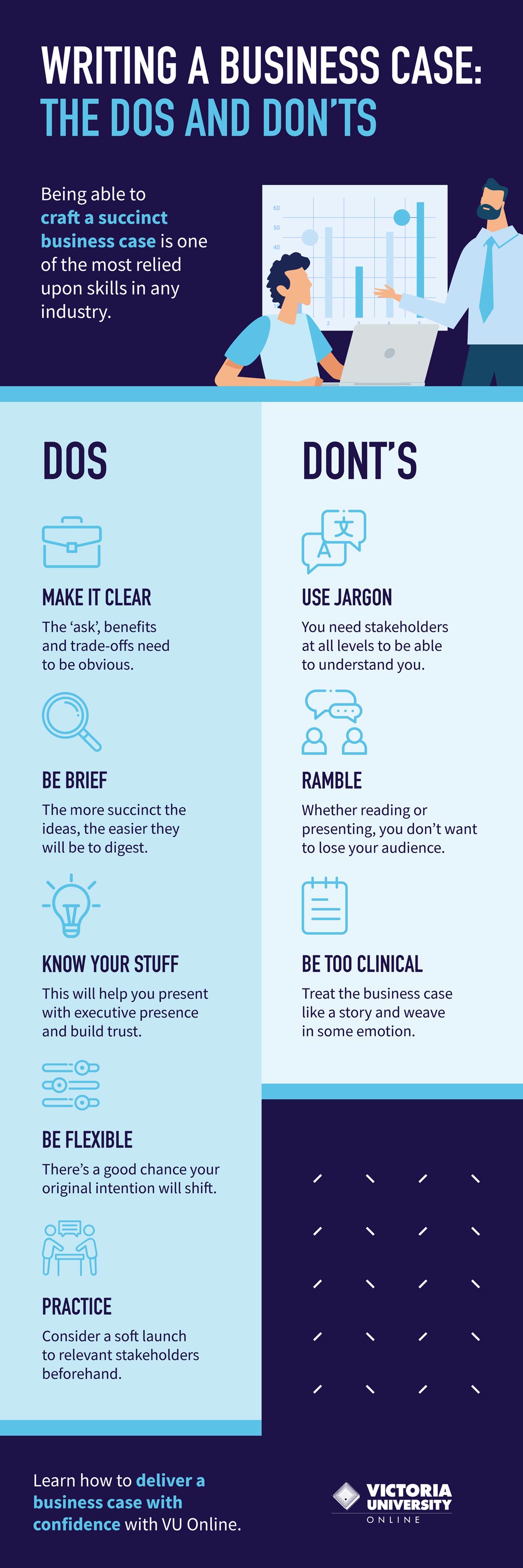
How to write a business case that sells
As far as transferable skills go, being able to craft a succinct business case is one of the most relied upon in any industry.
Designed to present a solution to a problem, a business case is the starting point for implementing any large-scale change in an organisation.
Identifying the best structure and framework for writing a business case isn’t always straightforward. The process and desired outcome may involve several stakeholders, so presenting the business case in an accessible manner is key. For MBA students, learning how to write a business case is often one of the most essential and practical skills they gain during their studies.
If you’re looking for an MBA that will help prepare you for senior leadership roles, VU’s 100% online Master of Business Administration will allow you to develop the strategic, analytical and financial skills you need.
Read on for a complete guide on what a business case entails, how to write and pitch one and, most importantly, the dos and don’ts to keep in mind.
What is a business case?
A business case is an organisational document that outlines an investment, strategy or initiative and its potential value to the organisation.
The document explores the problems that the project hopes to solve and gives a few possible solutions, typically recommending one. It will detail benefits, risks, values, requirements and resources to give the audience a complete picture.
Key stakeholders will use the case and its presentation to determine whether they agree with the plan, which is why it's crucial to get the project document right.
Business case vs business plan
Business cases are sometimes confused with business and project plans, but they refer to different things.
A business plan is focused on starting a new business and the most critical aspects of how the company will run.
A project plan occurs after successfully creating and presenting a business case, once the company stakeholders decide they want to proceed. This project plan is given to the project manager and will specify the practical details of the project, including timelines and parties involved.
What is the purpose of a business case?
The purpose of creating a business case is to share the proposal with key stakeholders to gain approval and alignment, ideally moving the business case into action promptly.
Rachael Bonetti is a former C-suite executive with 27 years of experience, now operating a company that helps other business owners and employees to manage their careers. During her tenure, Rachael reviewed many successful business cases and understands when they’re most beneficial.
“Usually, a business case is presented when you’re asking for something that isn’t budgeted for,” she says, “an initiative or project that’s slightly outside the strategic objectives.”
So, what is an example of a business case?
Say you’re planning on launching a new product or considering hiring a contractor to undertake major work for a company. First, you’ll need executive alignment from the C-suite or management teams and a business case can do just that.
This document will identify the benefits and core responsibilities for each stakeholder, clearly defining what the decision-makers need to assess and agree on for a project.

Writing a business case: The dos and don’ts
Being able to craft a succinct business case is one of the most relied upon skills in any industry.
Do
- Make it clear: the ‘ask’, benefits and trade-offs need to be obvious.
- Be brief: the more succinct the ideas, the easier they will be to digest.
- Know your stuff: this will help you present with executive presence and build trust.
- Be flexible: there’s a good chance your original intention will shift.
- Practice: consider a soft launch to relevant stakeholders beforehand.
Don't
- Use jargon: you need stakeholders at all levels to be able to understand you.
- Ramble: whether reading or presenting, you don’t want to lose your audience.
- Be too clinical: treat the business case like a story and weave in some emotion.
What perspectives need to be considered for a business case?
A solid business case needs to consider internal and external stakeholders and ensure the document informs each party.
Some examples of different perspectives a business case might require include:
Finance — The finance team will assess a business case to see whether it’s financially viable. The case should demonstrate that the business can afford the options presented, including a profit and loss analysis and potential risks.
Management — The managerial team overlooking the business case will want to see that plans are in place for delivering, monitoring and assessing the results. The best approach is to show how you will see a specific option through to completion and details of the project management involved.
Economic — For a business case to be economically viable, it needs to be able to demonstrate that it adds value to the company—socially, environmentally and otherwise. A focus on corporate social responsibility, or CSR, is recommended if the company has a model.
Strategic — Strategic management is how a company uses its resources to achieve goals. A good business case should be able to show how the project will align with the company's objectives.
Commercial — The commercial aspect of a business case will include information about the suppliers and contractors involved. This might detail how they’ll be chosen and the resources or services they’ll provide.
What should a business case contain?
A good business case is well-structured and integral to the change management process. It has everything that various stakeholders need in order to move forward with their decision in an easy-to-read format.
If you want to know how to structure a business case successfully, it is best to cover all aspects, ensuring that each section aligns with the primary objective.
Section 1: Executive summary
The executive summary serves as an overall description of the problem, options for solving the problem and a recommendation for the preferred solution. This section, when summarised succinctly, will allow the reader to anticipate the information ahead.
Section 2: Background information
As a business case involves many stakeholders, you must ensure everyone understands the project and its context so that they can make an informed choice. Relevant background information includes insights into previous projects, surveys and statistics, as well as a look at the issues that led to the business case being developed and a discussion about why the project is being introduced.
Section 3: Project definition
This comprehensive section goes into the finer details of the project, including the problems it’s addressing. A project definition should also cover the timeline for completion and the various stages it will follow.
Section 4: Business requirements
Any requirements that the business has that will impact the project should be listed here, along with details of how the project will meet them. These include specific suppliers the company must use, whether or not procedures must be adhered to and whether or not a budget must be met.
Section 5: Option presentation and evaluation
A solid business case must present multiple options for a solution without any bias attached. However, the detail needed for each option will vary depending on the company’s requirements. Sometimes, a simple list of possibilities with the best one selected is sufficient. Otherwise, some businesses want each option to come with detailed research.
Section 6: Presentation of the preferred option
The chosen option and desired solution need to be covered in greater detail. It is important to also include the selection criteria you used to choose it and why it is the best choice for this business.
Section 7: Strategic alignment
A solid business case aligns with the strategic direction of the company. A business case should demonstrate how the chosen option does this, mentioning how it meets specific organisational goals and objectives where possible. This shows the reader that you have considered all aspects and ensured future feasibility.
Section 8: Benefits
The benefits of the preferred option should be laid out, as well as the overall project's benefits. This is the main selling point of the business case and so the benefits need to be of high value, in order to make the reader want to achieve them.
Section 9: Risks
Many risks are involved in taking on a new project and a business case needs to define them clearly. These could be risks involving time, money, the workforce and public relations, just to name a few. Although making the stakes appear minimal to get the project approved might seem easier, it‘s better to be honest.
Business owner Rachael Bonnetti advises to also think about whether there’s going to be a compromise involved in pulling the project off, as this could be viewed as a risk. “Quite often a business case will say we can make this work if we stop doing something else. There’s usually a trade-off involved.”
Section 10: Project implementation plan
You will need an exhaustive layout of how the project will be implemented and this section will do that in detail. Here, include information like relevant stakeholders, resources and a timeline for each step in the plan. Having a clear idea of the exact details will make the stakeholders more likely to agree to the business case.
Section 11: Financial analysis
Money is a central aspect of any business project and in this section, you’ll need to lay out the finer financial details. This includes what it will cost, if the business can afford it, where the money will come from and the economic value of seeing it through.
Section 12: Resources required
Give a detailed outline of your project's resources and include them for all stages. This includes human resources, company resources, intellectual property, physical property and financial resources. The stakeholders should understand beyond just the finances what this project needs to succeed and what the ongoing resource commitment is.
Section 13: Authorisations
A project usually requires people to sign off and authorise things at different stages. This section of the business case will detail the personnel who can grant authorisations and the points at which authorisations will be required.
Section 14: Appendices
This section is for other information relevant to the business case and referenced within it. This includes financial modelling, market research, property plans or more information on the alternatives presented in the business case.
How to create a business case
Once you understand how to structure a business case, the writing process becomes less daunting. The following steps are what’s required to create a sound business case.
- Do your research first. Before you start writing, gather as much information as possible to help craft each section. You may learn about something that impacts the business case, takes it in a new direction or makes it entirely redundant.
- Ask for contributions. It’s not usual for a business case to be completed by just one person, nor is it recommended. A solid business case needs to have input from others, including stakeholders, industry experts and team members. For example, the financial analysis will need input from the finance team to verify the information. For this reason, make sure to consult the relevant parties.
- Create the case in stages. A business case is a comprehensive document requiring a slow approach. As you work through the case, seek input from stakeholders to confirm that you’re on the right track. If something needs to be changed, removed or added for clarity, it’s better to do it early rather than when you’re presenting the business case.
- Do the executive summary last. An executive summary should sum up the entirety of the business case in one to two pages. As such, you can only begin writing it once you’ve finished the document. Avoid the urge to start with the executive summary, because if you do, you’ll be trying to mould the business case to the summary.
- Create an elevator pitch. With the document complete and refined, you’ll want to create an elevator pitch that helps you sell the idea. This is a sentence or two that covers the what, the why and the how of your business case in preparation for presenting it.
Business case dos and don’ts
A business case can be overwhelming to create and present, especially if it’s your first time. Check out these dos and don’ts of writing and pitching a business case that will help get you started.
The Dos
- Make it evident from the get-go what your business case is about. “The ‘ask’ should be clear. The benefits should be clear. And the trade-offs should be clear,” says Rachael.
- Be brief with your writing. The more succinct the ideas, the easier they will be to digest.
- Get a good grasp on the business case before you pitch it. Rachel says, “The people who know their stuff and present with executive presence are more likely to build trust and credibility.”
- Be prepared to make changes. As you research and get contributions from various team members and stakeholders, there’s a good chance your original intention will shift.
- Consider a soft launch of the business case to some of the relevant stakeholders before you go for the real deal.
The Don’ts
- Avoid using jargon and assumed knowledge. Remember that various stakeholders will be reviewing this, internally and externally, and you want them to be able to understand it.
- Try not to make the business case too long. Whether reading or presenting it, you don’t want to lose your audience.
- Don’t make it too clinical. Rather than relying on facts and figures alone, treat the business case like a story and weave in some emotion.
How an MBA can help
As a document that has a significant impact on a business and one that takes ideas from planning through to completion, knowing how to create a good one is vital. Thankfully, a Master of Business Administration (MBA), can teach you how to write a business case that sells, how to present it confidently and how to ensure successful implementation.
Preparing you for success: the value of an MBA qualification for all areas of business
An MBA is your key to navigating the executive world and it will equip you with the skills you’ll need day to day in your professional life. In addition to learning how to write a business case, here are some of the broader areas of skills that an MBA can give you.
- Critical and analytical thinking — From problem-solving, assessing business threats and objectives, and making fact-based comparisons, an MBA will teach you how to guide an organisation in the right direction.
- Communication — An MBA covers topics like active listening, conflict resolution and emotional intelligence, helping you to become an effective communicator.
- Innovation — A business leader needs to implement change, boost productivity and not be afraid to try new things. An MBA can build innovation and entrepreneurial skills to help you do all this and more.
- Research and risk management — No business exists without risks but understanding them and knowing how to avoid them is a powerful skill. This course covers financial analysis and organisational change management to help you understand your business.
- Leadership — An MBA gives you the skills needed to lead a team successfully. A good leader must wear many hats, including that of an innovator, motivator, mentor and manager.
What is an MBA specialisation?
If your career development goals are more industry-specific skills or you’re aiming for a particular role, studying a specialised MBA may be a better move. A more specific discipline is recommended for some students, but a traditional MBA is still the preferred choice for career development in general business.
Victoria University’s (VU) 100% online MBA offers specialisations in two areas:
- Change Management — The Master of Business Administration (Change Management) teaches you the skills to implement and adapt to change as a business leader. Project Manager, Human Resources Manager and Change Management Consultant are professions that could benefit from this education.
- Finance — A Master of Business Administration (Finance) is ideal for students interested in finance and financial management. Career outcomes for this specialist course include Financial Consultant, Chief Financial Officer and Financial Manager.
Leading professional conversations and business cases
With an MBA under your belt, your career will gain forward momentum. You’ll have a host of practical skills, like the ability to craft and implement a solid business case and soft skills that can be applied in all industries. Better still, it gives graduates the chance to earn a higher income while they take the career path they’ve always wanted.
Average MBA graduate salary
Your salary is usually determined by job title, employer, industry, previous work experience and qualifications. Having a masters can make a significant impact on your worth as an employee. Because while having an MBA is not an automatic ticket to a higher income, it does help.
Reports on the average MBA graduate salary show that Australian MBA earners make more than others in the Oceania region, with an average income between $85,000 and $305,000 yearly. An MBA makes you a more attractive candidate and gives you a bargaining chip to earn a better salary.
There’s good news for female MBA graduates as well. VU Online found that the average salary increase for a woman after earning an MBA was $38,056. Of female MBA earners, 78 per cent would recommend studying for an MBA to other women. It’s a smart move if you want to advance your career and earn the money you’re worth.
Career options after an MBA
An MBA opens up a world of careers that might not have been possible before, including those in your existing field and outside. With the skills and experience needed to excel in all kinds of business, you’ll have much more flexibility in your path.
If you’re planning to study and want to explore what your future could look like, these are just a few possible career options after an MBA.
- Systems Manager
- Program Manager
- Marketing Manager
- IT Manager
- Entrepreneur
- Account Executive
- Business Consultant
- Policy Analyst
One of the benefits of studying an MBA online is that you can continue to move forward with your career as you learn part-time. This flexible arrangement allows you to fast-track your career development and emerge on the other side as a more valuable asset without ever missing a beat.
Grow with the skills an MBA can teach, from business cases and beyond
Learning how to create a business case is just one part of becoming a success in the world of business. An MBA can help you realise your full potential and equip you with the skills you need to succeed in your career.
VU Online’s award-winning postgraduate Block Model is a unique way to fast-track your studies and launch yourself into the profession you’ve always wanted sooner. The MBA can be completed in two years part-time and because it’s online, you can study when it suits you.
Check out the MBA course page for information on the course, or speak to one of our Student Enrolment Advisors to find out more. We can talk you through the options for flexible study, whether studying an MBA specialisation is right for you and your eligibility for the course.
The best time to study an MBA is now. The best way to do it is through VU Online.
-
View previous article
 A day in the life of a primary school teacher17 November 2022
A day in the life of a primary school teacher17 November 2022 -
View next article
 7 career paths in financial planning30 January 2023
7 career paths in financial planning30 January 2023

